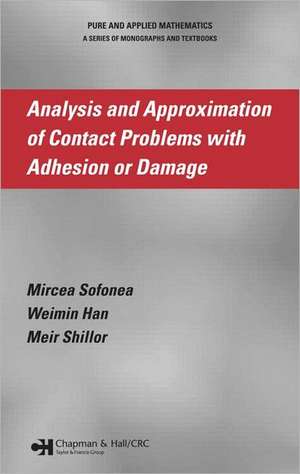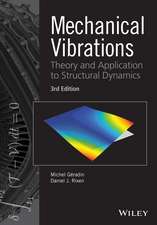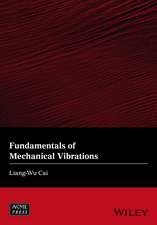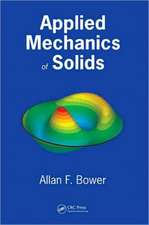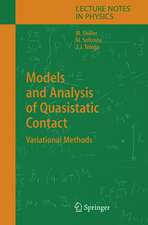Analysis and Approximation of Contact Problems with Adhesion or Damage: Chapman & Hall/CRC Pure and Applied Mathematics
Autor Mircea Sofonea, Weimin Han, Meir Shilloren Limba Engleză Hardback – 26 sep 2005
Employing recent results on elliptic and evolutionary variational inequalities, convex analysis, nonlinear equations with monotone operators, and fixed points of operators, Analysis and Approximation of Contact Problems with Adhesion or Damage places these important tools and results at your fingertips in a unified, accessible reference.
Din seria Chapman & Hall/CRC Pure and Applied Mathematics
- 9%
 Preț: 675.62 lei
Preț: 675.62 lei - 9%
 Preț: 735.89 lei
Preț: 735.89 lei - 9%
 Preț: 1725.78 lei
Preț: 1725.78 lei - 15%
 Preț: 489.26 lei
Preț: 489.26 lei - 15%
 Preț: 499.08 lei
Preț: 499.08 lei - 15%
 Preț: 485.18 lei
Preț: 485.18 lei - 12%
 Preț: 313.61 lei
Preț: 313.61 lei - 15%
 Preț: 489.26 lei
Preț: 489.26 lei - 26%
 Preț: 1210.38 lei
Preț: 1210.38 lei - 20%
 Preț: 464.60 lei
Preț: 464.60 lei - 18%
 Preț: 802.96 lei
Preț: 802.96 lei - 15%
 Preț: 489.26 lei
Preț: 489.26 lei - 18%
 Preț: 902.42 lei
Preț: 902.42 lei - 15%
 Preț: 461.03 lei
Preț: 461.03 lei - 18%
 Preț: 897.70 lei
Preț: 897.70 lei - 15%
 Preț: 461.03 lei
Preț: 461.03 lei - 26%
 Preț: 1349.55 lei
Preț: 1349.55 lei - 15%
 Preț: 461.03 lei
Preț: 461.03 lei - 18%
 Preț: 846.08 lei
Preț: 846.08 lei - 32%
 Preț: 1391.07 lei
Preț: 1391.07 lei - 26%
 Preț: 878.00 lei
Preț: 878.00 lei - 26%
 Preț: 1466.15 lei
Preț: 1466.15 lei - 15%
 Preț: 488.43 lei
Preț: 488.43 lei - 15%
 Preț: 489.26 lei
Preț: 489.26 lei - 15%
 Preț: 489.26 lei
Preț: 489.26 lei - 18%
 Preț: 2074.78 lei
Preț: 2074.78 lei - 15%
 Preț: 489.26 lei
Preț: 489.26 lei - 18%
 Preț: 973.19 lei
Preț: 973.19 lei - 15%
 Preț: 461.03 lei
Preț: 461.03 lei - 18%
 Preț: 1280.44 lei
Preț: 1280.44 lei - 8%
 Preț: 418.23 lei
Preț: 418.23 lei - 20%
 Preț: 827.30 lei
Preț: 827.30 lei - 15%
 Preț: 461.03 lei
Preț: 461.03 lei - 26%
 Preț: 1293.09 lei
Preț: 1293.09 lei - 15%
 Preț: 461.03 lei
Preț: 461.03 lei - 26%
 Preț: 1407.83 lei
Preț: 1407.83 lei - 18%
 Preț: 2210.92 lei
Preț: 2210.92 lei - 18%
 Preț: 787.17 lei
Preț: 787.17 lei - 15%
 Preț: 489.26 lei
Preț: 489.26 lei - 18%
 Preț: 1935.49 lei
Preț: 1935.49 lei - 26%
 Preț: 874.34 lei
Preț: 874.34 lei - 18%
 Preț: 1796.21 lei
Preț: 1796.21 lei - 18%
 Preț: 2212.49 lei
Preț: 2212.49 lei - 25%
 Preț: 639.72 lei
Preț: 639.72 lei -
 Preț: 389.38 lei
Preț: 389.38 lei - 21%
 Preț: 380.81 lei
Preț: 380.81 lei
Preț: 766.85 lei
Preț vechi: 1028.97 lei
-25% Nou
Puncte Express: 1150
Preț estimativ în valută:
146.77€ • 151.26$ • 123.91£
146.77€ • 151.26$ • 123.91£
Carte tipărită la comandă
Livrare economică 03-17 martie
Preluare comenzi: 021 569.72.76
Specificații
ISBN-13: 9781584885856
ISBN-10: 1584885858
Pagini: 238
Dimensiuni: 152 x 229 x 18 mm
Greutate: 0.6 kg
Ediția:New.
Editura: CRC Press
Colecția Chapman and Hall/CRC
Seria Chapman & Hall/CRC Pure and Applied Mathematics
ISBN-10: 1584885858
Pagini: 238
Dimensiuni: 152 x 229 x 18 mm
Greutate: 0.6 kg
Ediția:New.
Editura: CRC Press
Colecția Chapman and Hall/CRC
Seria Chapman & Hall/CRC Pure and Applied Mathematics
Public țintă
ProfessionalCuprins
Modeling and Mathematical Background. Basic Equations and Boundary Conditions. Preliminaries on Functional Analysis. Preliminaries on Numerical Analysis. Frictionless Contact Problems with Adhesion. Quasistatic Viscoelastic Contact with Adhesion. Dynamic Viscoelastic Contact with Adhesion. Quasistatic Viscoplastic Contact with Adhesion. Contact Problems with Damage. Quasistatic Viscoelastic Contact with Damage. Dynamic Viscoelastic Contact with Damage. Quasistatic Viscoplastic Contact with Damage. Notes, Comments, and Conclusions. Bibliographical Notes, Problems for Future Research, and Conclusions. References. Index.
Recenzii
“This book summarizes and completes the work of the authors on the topic of dynamic and quasistatic contact problems with adhesion or damage of viscoelastic structures in recent years. Different models involving adhesion and material damages are presented with both the theoretical result (existence and uniqueness of a weak solution) and the numerical analysis result (optimal convergence of discrete approximation by finite element methods) in a unified framework. The book is well presented and easy to read.”
— Yves Renard, (Villeurbanne), in Mathematical Reviews, Issue 2007f gt; A Seminal Contribution to the Field by Renowned Researchers
— Yves Renard, (Villeurbanne), in Mathematical Reviews, Issue 2007f gt; A Seminal Contribution to the Field by Renowned Researchers
Notă biografică
Mircea Sofonea, Weimin Han, Meir Shillor
Descriere
Beginning with an introduction to modeling and functional and numerical analysis, Analysis and Approximation of Contact Problems with Adhesion or Damage devotes individual chapters to models involving adhesion and material damage, with each chapter exploring a particular model. For each model, the authors provide a variational formulation and establish the existence and uniqueness of a weak solution. They study a fully discrete approximation scheme that uses the finite element method to discretize the spatial domain and finite differences for the time derivatives. The final section summarizes the results, presents bibliographic comments, and considers future directions in the field.
